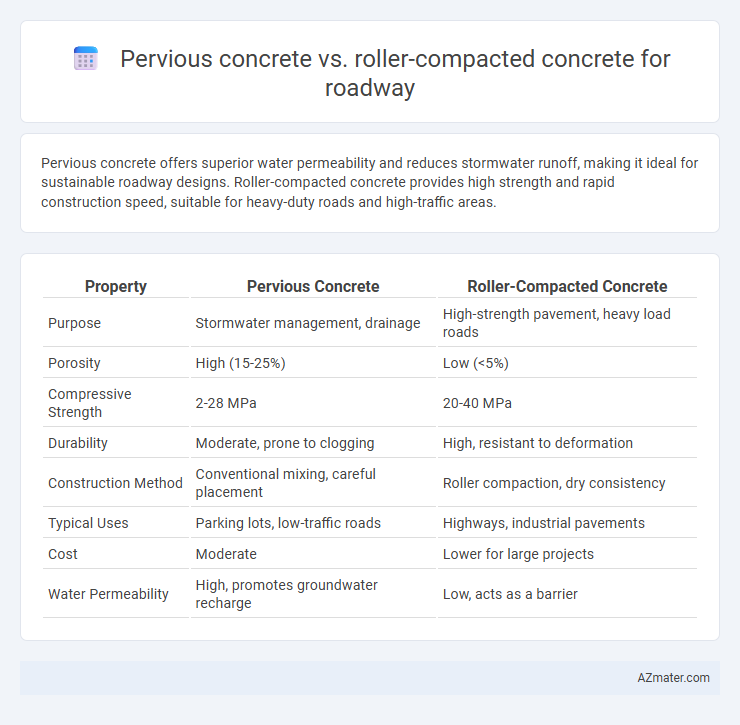Pervious concrete offers superior water permeability and reduces stormwater runoff, making it ideal for sustainable roadway designs. Roller-compacted concrete provides high strength and rapid construction speed, suitable for heavy-duty roads and high-traffic areas.
Table of Comparison
| Property | Pervious Concrete | Roller-Compacted Concrete |
|---|---|---|
| Purpose | Stormwater management, drainage | High-strength pavement, heavy load roads |
| Porosity | High (15-25%) | Low (<5%) |
| Compressive Strength | 2-28 MPa | 20-40 MPa |
| Durability | Moderate, prone to clogging | High, resistant to deformation |
| Construction Method | Conventional mixing, careful placement | Roller compaction, dry consistency |
| Typical Uses | Parking lots, low-traffic roads | Highways, industrial pavements |
| Cost | Moderate | Lower for large projects |
| Water Permeability | High, promotes groundwater recharge | Low, acts as a barrier |
Introduction to Pervious Concrete and Roller-Compacted Concrete
Pervious concrete is a highly porous material designed to allow water infiltration, thus reducing runoff and promoting groundwater recharge, making it ideal for sustainable roadway applications. Roller-compacted concrete (RCC) is a dry mix concrete, compacted with rollers to create a dense, high-strength pavement commonly used for heavy-traffic roadways and industrial surfaces. Both materials offer distinct advantages in durability and environmental performance, with pervious concrete focusing on permeability and runoff control, while RCC emphasizes structural strength and rapid construction.
Key Material Composition Differences
Pervious concrete primarily consists of cement, coarse aggregates, and minimal fine aggregates to create a highly porous structure that facilitates water permeability, ideal for sustainable roadway drainage. Roller-compacted concrete (RCC) uses a drier mix with lower cement content and higher coarse aggregate proportion, compacted by roller equipment to achieve a dense, durable pavement surface suitable for heavy traffic loads. The contrast in aggregate gradation and water-cement ratio directly influences hydraulic conductivity and load-bearing capacity between pervious concrete and RCC in road construction.
Strength and Durability Comparison
Pervious concrete offers lower compressive strength, typically ranging from 2,500 to 4,000 psi, making it suitable for low-traffic or drainage-sensitive roadways, while roller-compacted concrete (RCC) achieves higher strength levels between 4,500 to 6,000 psi, supporting heavy traffic loads and industrial use. In terms of durability, RCC exhibits superior resistance to abrasion, freeze-thaw cycles, and chemical attacks due to its dense, compacted matrix, whereas pervious concrete, with its porous structure, emphasizes permeability for stormwater management but is more vulnerable to clogging and surface wear. The choice between these concretes depends on balancing structural load requirements with environmental drainage needs, where RCC ensures long-term durability and strength, and pervious concrete promotes sustainable water infiltration.
Permeability and Drainage Features
Pervious concrete offers superior permeability with porosity typically between 15-25%, allowing water to flow through rapidly and reduce surface runoff on roadways. Roller-compacted concrete (RCC) features much lower permeability due to its dense matrix, making it less effective for drainage but providing high compressive strength suitable for heavy traffic loads. The enhanced drainage capacity of pervious concrete mitigates hydroplaning and improves stormwater management, whereas RCC is favored for structural durability when permeability is a lesser concern.
Installation Methods and Construction Speed
Pervious concrete installation requires careful placement with specialized equipment to maintain void structure, often involving a rake or roller screed, which can slow down construction speed compared to conventional methods. Roller-compacted concrete (RCC) utilizes heavy machinery like vibratory rollers for rapid compaction and paving, enabling faster construction and earlier opening to traffic. RCC's efficient installation process makes it preferable for large-scale roadway projects demanding accelerated schedules, while pervious concrete suits applications prioritizing stormwater management.
Maintenance Requirements
Pervious concrete requires regular vacuuming or pressure washing to prevent clogging and maintain permeability, making its maintenance frequency higher compared to roller-compacted concrete. Roller-compacted concrete exhibits minimal maintenance needs due to its dense, low-porosity structure, resulting in superior durability and reduced surface repairs. Both materials benefit from periodic inspections, yet pervious concrete demands more proactive upkeep to sustain pavement performance and water infiltration capabilities.
Environmental Impact and Sustainability
Pervious concrete significantly reduces stormwater runoff by allowing water to infiltrate through its porous structure, aiding groundwater recharge and minimizing urban flooding risks. Roller-compacted concrete (RCC), although denser and less permeable, offers high durability with lower cement content compared to traditional concrete, reducing carbon emissions associated with production. Both materials contribute to sustainable roadway construction, but pervious concrete provides superior environmental benefits in water management, while RCC excels in resource efficiency and long-term structural performance.
Cost Analysis and Economic Considerations
Pervious concrete offers significant stormwater management benefits but typically incurs higher initial material and installation costs compared to roller-compacted concrete (RCC), which is valued for its lower cost and rapid construction in roadway applications. The economic considerations for RCC include reduced labor expenses and faster project timelines, leading to cost savings, whereas pervious concrete may reduce long-term maintenance and drainage infrastructure expenditures. Life-cycle cost analysis often favors RCC for budget-constrained projects, but pervious concrete can provide economic advantages in areas with stringent environmental regulations or high stormwater management requirements.
Ideal Applications for Roadway Projects
Pervious concrete is ideal for roadway projects requiring enhanced stormwater management and groundwater recharge, making it suitable for low-traffic areas, parking lots, and urban streets where environmental sustainability is a priority. Roller-compacted concrete (RCC) excels in heavy-duty roadway applications such as highways, airport pavements, and industrial roads due to its high compressive strength, rapid construction, and durability under heavy traffic loads. Selecting between pervious concrete and RCC depends on balancing permeability requirements with structural demands for specific roadway conditions.
Conclusion: Selecting the Right Concrete for Roadways
Pervious concrete offers superior stormwater management by enhancing permeability and reducing runoff, making it ideal for sustainable urban roadways. Roller-compacted concrete provides exceptional strength and durability, suitable for high-traffic and heavy-load road applications. Choosing the right concrete depends on prioritizing environmental benefits with pervious concrete or structural performance with roller-compacted concrete for effective roadway solutions.

Infographic: Pervious concrete vs Roller-compacted concrete for Roadway
 azmater.com
azmater.com